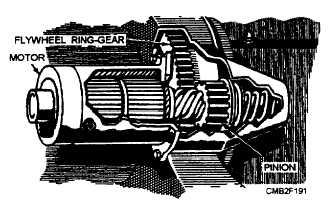PINION DRIVE ASSEMBLY - The pinion gear, pinion drive mechanism, and solenoid.
FIELD FRAME - The center housing that holds the field coils and pole shoes.
DRIVE END FRAME - The end housing around the pinion gear, which has a bushing for the armature shaft.
ARMATURE ASSEMBLY. - The armature assembly consists of an armature shaft, armature core, commutator, and armature windings.
The armature shaft supports the armature assembly as it spins inside the starter housing. The armature core is made of iron and holds the armature windings in place. The iron increases the magnetic field strength of the windings.
The commutator serves as a sliding electrical connection between the motor windings and the brushes and is mounted on one end of the armature shaft. The commutator has many segments that are insulated from each other. As the windings rotate away from the pole shoe (piece), the commutator segments change the electrical connection between the brushes and the windings. This action reverses the magnetic field around the windings. The constant changing electrical connection at the windings keeps the motor spinning.
COMMUTATOR END FRAME. - The commutator end frame houses the brushes, the brush springs, and the armature shaft bushing.
The brushes ride on top of the commutator. They slide on the commutator to carry battery current to the spinning windings. The springs force the brushes to maintain contact with the commutator as it spins, thereby no power interruptions occurs. The armature shaft bushing supports the commutator end of the armature shaft.
PINION DRIVE ASSEMBLY. - The pinion drive assembly includes the pinion gear, the pinion drive mechanism, and solenoid. There are two ways that a starting motor can engage the pinion assembly - (1) with a moveable pole shoe that engages the pinion gear and (2) with a solenoid and shift fork that engages the pinion gear.
The pinion gear is a small gear on the armature shaft that engages the ring gear on the flywheel. Most starter pinion gears are made as part of a pinion drive mechanism. The pinion drive mechanism slides over one end of the starter armature shaft. The pinion drive mechanism found on starting motors that you will encounter are of three designs - Bendix drive, overrunning clutch, and Dyer drive.
The BENDIX DRIVE (fig. 2-38) relies on the principle of inertia to cause the pinion gear to mesh with the ring gear. When the starting motor is not operating, the pinion gear is out of mesh and entirely away from the ring gear. When the ignition switch is engaged, the total battery voltage is applied to the starting motor, and the armature immediately starts to rotate at high speed.
The pinion, being weighted on one side and having internal screw threads, does not rotate immediately with the shaft but because of inertia, runs forward on the revolving threaded sleeve until it engages with the ring gear. If the teeth of the pinion and ring gear do not engage, the drive spring allows the pinion to revolve and forces the pinion to mesh with the ring gear. When the pinion gear is engaged fully with the ring gear, the pinion is then driven by the starter through the compressed drive spring and cranks the engine. The drive spring acts as a cushion while the engine is being cranked against compression. It also breaks the severity of the shock on the teeth when the gears engage and when the engine kicks back due to ignition. When the engine starts and runs on its own power, the ring gear drives the pinion at a higher speed than does the starter. This action causes the pinion to turn in the opposite direction on the threaded sleeve and automatically disengages from the ring gear. This prevents the engine from driving the starter.
The OVERRUNNING CLUTCH (fig. 2-39) provides positive meshing and demeshing of the starter motor pinion gear and the ring gear. The starting motor armature shaft drives the shell and sleeve assembly of the clutch. The rotor assembly is connected to the pinion gear which meshes with the engine ring gear. Spring-loaded steel rollers are located in tapered notches between the shell and the rotor. The springs

Figure 2-38. - Starting motor with a Bendix drive.
Continue Reading